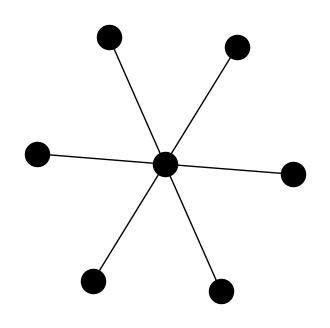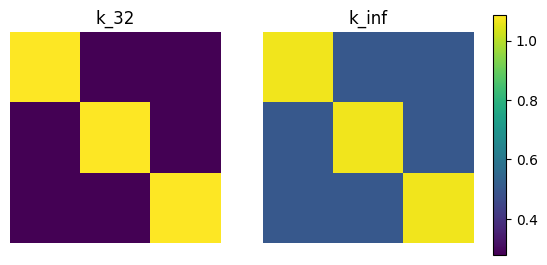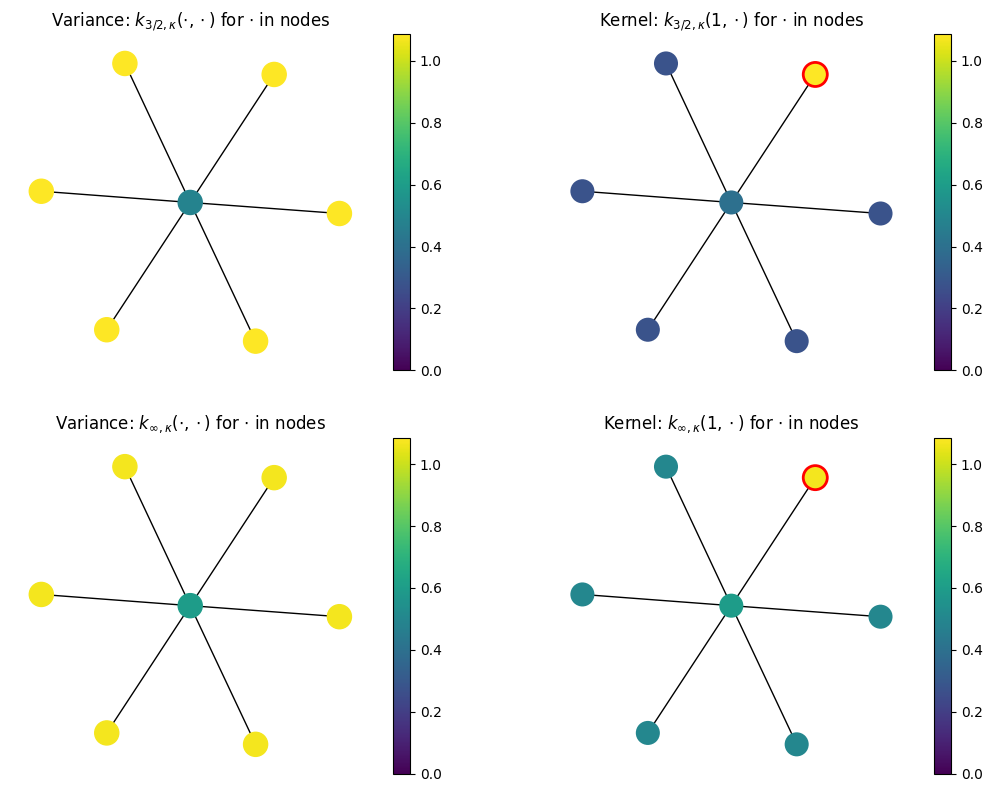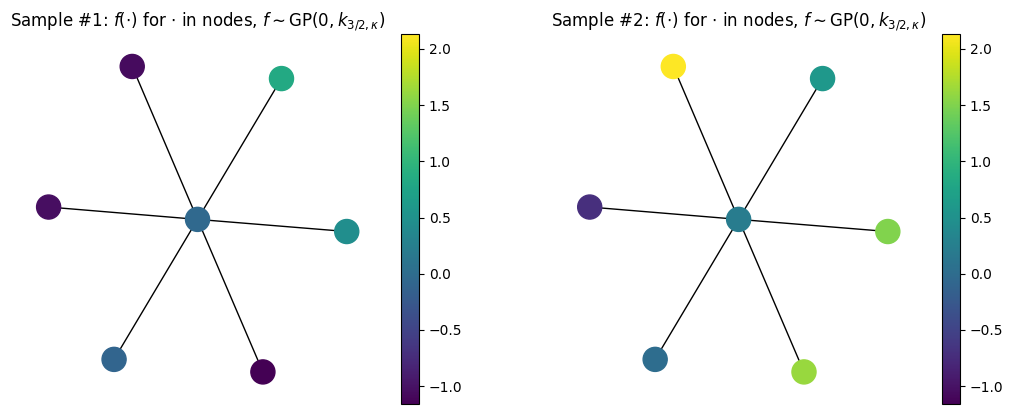[1]:
# To run this in Google Colab, uncomment the following line
# !pip install geometric_kernels
# If you want to use a version of the library from a specific branch on GitHub,
# say, from the "devel" branch, uncomment the line below instead
# !pip install "git+https://github.com/geometric-kernels/GeometricKernels@devel"
Matérn and Heat Kernels on Graphs¶
This notebook shows how define and evaluate kernels on a simple graph. By this we mean kernels \(k: V \times V \to \mathbb{R}\) where \(V\) is a vertex set of a graph. The graph must be undirected and have nonnegative weights. The edges of this graph define the geometry: you expect that nodes connected by edges with large weights to be more correlated than nodes connected by edges with small weights.
At the very end of the notebook we also show how to construct approximate finite-dimensional feature maps for the kernels on graphs and how to use these to efficiently sample the Gaussian processes \(\mathrm{GP}(0, k)\).
We use the numpy backend here.
Important: if you want to model a signal on the edges of a graph \(G\), you can consider modeling the signal on the nodes of the line graph. The line graph of \(G\) has a node for each edge of \(G\) and its two nodes are connected by an edge if the corresponding edges in \(G\) used to share a common node. To build the line graph, you can use the
line_graph function of networkx. Alternatively, especially for the flow-type data, you might want to use specialized edge kernels. For these, take a look into GraphEdges.ipynb. If you want to model a singal on a metric graph, take a look into Bolin et al.
(2023) —owever, the machinery from this paper is not currently implemented in GeometricKernels.
Contents¶
Basics¶
[2]:
# Import a backend, we use numpy in this example.
import numpy as np
# Import the geometric_kernels backend.
import geometric_kernels
# Note: if you are using a backend other than numpy,
# you _must_ uncomment one of the following lines
# import geometric_kernels.tensorflow
# import geometric_kernels.torch
# import geometric_kernels.jax
# Import a space and an appropriate kernel.
from geometric_kernels.spaces import Graph
from geometric_kernels.kernels import MaternGeometricKernel
# We use networkx to visualize graphs
import networkx as nx
import matplotlib as mpl
import matplotlib.pyplot as plt
INFO (geometric_kernels): Numpy backend is enabled, as always. To enable other backends, don't forget `import geometric_kernels.*backend name*`.
Defining a Space¶
First we create and visualize a simple star graph using networkx
[3]:
nx_graph = nx.star_graph(6)
Define graph layout to reuse it later on (so that graph appears the same on all pictures).
[4]:
pos = nx.spring_layout(nx_graph)
Visualize the graph.
[5]:
plt.figure(figsize=(4,4))
nx.draw(nx_graph, node_color = 'black', ax=plt.gca(), pos=pos)
plt.show()

The following cell turns the nx_graph created above into a GeometricKernels Graph space.
The normalize_laplacian parameter controls whether to use the eigenvectors of the unnormalized Laplacian or the symmetric normalized Laplacian as features (see the optional Theory section below for details). You may want to try both normalize_laplacian=False and normalize_laplacian=True for your task. The former is the default.
[6]:
graph = Graph(np.array(nx.to_numpy_array(nx_graph)), normalize_laplacian=False)
Defining a Kernel¶
First, we create a generic Matérn kernel.
To initialize MaternGeometricKernel you just need to provide a Space object, in our case this is the graph we have just created above.
There is also an optional second parameter num which determines the order of approximation of the kernel (number of levels). There is a sensible default value for each of the spaces in the library, so change it only if you know what you are doing.
A brief account on theory behind the kernels on graphs can be found on this documentation page.
[7]:
kernel = MaternGeometricKernel(graph)
To support JAX, our classes do not keep variables you might want to differentiate over in their state. Instead, some methods take a params dictionary as input, returning its modified version.
The next line initializes the dictionary of kernel parameters params with some default values.
Note: our kernels do not provide the outputscale/variance parameter frequently used in Gaussian processes. However, it is usually trivial to add it by multiplying the kernel by an (optimizable) constant.
[8]:
params = kernel.init_params()
print('params:', params)
params: {'lengthscale': array(1.), 'nu': array(inf)}
To define two different kernels, Matern-3/2 and Matern-∞ (aka heat, RBF, squared exponential, diffusion), we need two different versions of params we define below.
Note: unlike the Euclidean or the manifold case, the \(1/2, 3/2, 5/2\) may fail to be the reasonable values of \(\nu\). On the other hand, the parameter \(\nu\) is optimizable in the same way in which the legnthscale is. Keep in mind though, that the optimization problem may require finding some trial and error to find good a initialization and that reasonable \(\kappa\) and \(\nu\) will heavily depend on the specific graph in a way that is hard to predict.
Note: consider a graph with the scaled adjacency \(\mathbf{A}' = \alpha^2 \mathbf{A}\), for some \(\alpha > 0\). Denote the kernel corresponding to \(\mathbf{A}\) by \(k_{\nu, \kappa}\) and the kernel corresponding to \(\mathbf{A}'\) by \(k_{\nu, \kappa}'\). Then, as apparent from the theory, for the normalized graph Laplacian we have \(k_{\nu, \kappa}' (i, j) = k_{\nu, \kappa} (i, j)\). On the other hand, for the unnormalized graph Laplacian, we have \(k_{\nu, \kappa}' (i, j) = k_{\nu, \alpha \cdot \kappa} (i, j)\), i.e. the lengthscale changes.
[9]:
params["lengthscale"] = np.array([2.0])
params_32 = params.copy()
params_inf = params.copy()
del params
params_32["nu"] = np.array([3/2])
params_inf["nu"] = np.array([np.inf])
Now two kernels are defined and we proceed to evaluating both on a set of random inputs.
Evaluating Kernels on Random Inputs¶
We start by sampling 3 (uniformly) random points on our graph. An explicit key parameter is needed to support JAX as one of the backends.
[10]:
key = np.random.RandomState(1234)
key, xs = graph.random(key, 3)
print(xs)
[[3]
[6]
[5]]
Now we evaluate the two kernel matrices.
[11]:
kernel_mat_32 = kernel.K(params_32, xs, xs)
kernel_mat_inf = kernel.K(params_inf, xs, xs)
Finally, we visualize these matrices using imshow.
[12]:
# find common range of values
minmin = np.min([np.min(kernel_mat_32), np.min(kernel_mat_inf)])
maxmax = np.max([np.max(kernel_mat_32), np.max(kernel_mat_inf)])
fig, (ax1, ax2) = plt.subplots(nrows=1, ncols=2)
cmap = plt.get_cmap('viridis')
ax1.imshow(kernel_mat_32, vmin=minmin, vmax=maxmax, cmap=cmap)
ax1.set_title('k_32')
ax1.set_axis_off()
ax2.imshow(kernel_mat_inf, vmin=minmin, vmax=maxmax, cmap=cmap)
ax2.set_title('k_inf')
ax2.set_axis_off()
# add space for color bar
fig.subplots_adjust(right=0.85)
cbar_ax = fig.add_axes([0.88, 0.25, 0.02, 0.5])
# add colorbar
sm = plt.cm.ScalarMappable(cmap=cmap,
norm=plt.Normalize(vmin=minmin, vmax=maxmax))
fig.colorbar(sm, cax=cbar_ax)
plt.show()

Visualizing Kernels¶
Here we visualize \(k_{\nu, \kappa}(\) base_point \(, x)\) for $x \in `$ ``other_points`. We define base_point and other_points in the next cell.
[13]:
base_point = 1 # choosing a fixed node for kernel visualization
other_points = np.arange(graph.num_vertices)[:, None]
The next cell evaluates \(k_{\nu, \kappa}(\) base_point \(, x)\) for $x \in `$ ``other_points` for \(\nu\) either \(3/2\) or \(\infty\).
[14]:
values_32 = kernel.K(params_32, np.array([[base_point]]),
other_points).flatten()
values_inf = kernel.K(params_inf, np.array([[base_point]]),
other_points).flatten()
We also evaluate the variances \(k_{\nu, \kappa}(x, x)\) for $x \in `$ ``other_points` for \(\nu\) either \(3/2\) or \(\infty\).
[15]:
# Get prior variances k(*, *) for * in nodes:
variance_32 = kernel.K_diag(params_32, other_points)
variance_inf = kernel.K_diag(params_inf, other_points)
Here are the actual visualization routines.
Note: the top right plot shows k(base_point, *) where * goes through all nodes and base_point has red outline.
[16]:
cmap = plt.get_cmap('viridis')
# Set the colorbar limits:
vmin = min(0.0, values_32.min(), values_inf.min())
vmax = max(1.0, variance_32.max(), variance_inf.max())
# Red outline for the base_point:
edgecolors = [(0, 0, 0, 0)]*graph.num_vertices
edgecolors[base_point] = (1, 0, 0, 1)
# Save graph layout so that graph appears the same in every plot
kwargs = {'pos': pos}
fig, ((ax1, ax2), (ax3, ax4)) = plt.subplots(2, 2, figsize=(12.8, 9.6))
# Plot variance 32
nx.draw(nx_graph, ax=ax1, cmap=cmap, node_color=variance_32,
vmin=vmin, vmax=vmax, **kwargs)
sm = plt.cm.ScalarMappable(cmap=cmap,
norm=plt.Normalize(vmin=vmin, vmax=vmax))
cbar = plt.colorbar(sm, ax=ax1)
ax1.set_title('Variance: $k_{3/2, \kappa}(\cdot, \cdot)$ for $\cdot$ in nodes')
# Plot kernel values 32
nx.draw(nx_graph, ax=ax2, cmap=cmap, node_color=values_32,
vmin=vmin, vmax=vmax, edgecolors=edgecolors,
linewidths=2.0, **kwargs)
sm = plt.cm.ScalarMappable(cmap=cmap,
norm=plt.Normalize(vmin=vmin, vmax=vmax))
cbar = plt.colorbar(sm, ax=ax2)
ax2.set_title('Kernel: $k_{3/2, \kappa}($%d$, \cdot)$ for $\cdot$ in nodes' % base_point)
# Plot variance inf
nx.draw(nx_graph, ax=ax3, cmap=cmap, node_color=variance_inf,
vmin=vmin, vmax=vmax, **kwargs)
sm = plt.cm.ScalarMappable(cmap=cmap,
norm=plt.Normalize(vmin=vmin, vmax=vmax))
cbar = plt.colorbar(sm, ax=ax3)
ax3.set_title('Variance: $k_{\infty, \kappa}(\cdot, \cdot)$ for $\cdot$ in nodes')
# Plot kernel values inf
nx.draw(nx_graph, ax=ax4, cmap=cmap, node_color=values_inf,
vmin=vmin, vmax=vmax, edgecolors=edgecolors,
linewidths=2.0, **kwargs)
sm = plt.cm.ScalarMappable(cmap=cmap,
norm=plt.Normalize(vmin=vmin, vmax=vmax))
cbar = plt.colorbar(sm, ax=ax4)
ax4.set_title('Kernel: $k_{\infty, \kappa}($%d$, \cdot)$ for $\cdot$ in nodes' % base_point)
plt.show()

A Note on Prior Variance¶
Note that the variance changes from node to node on this graph.
For example, for the unnormalized Laplacian, the variance is related to the expected return time of a random walk: how many steps, on average, does it take a particle randomly walking over the graph and starting in node x to return back to node x. For the center node, the expected return time is 2. For other nodes, it is always higher. Hence the variance in the center is lower than in the other nodes. This argument is inspired by Borovitskiy et al. (2021).
For the symmetric normalized Laplacian the situation is different.
See this Jupyter notebook for more examples of how variance differs for different graphs.
[17]:
print('Variance in the center node is %0.2f,' % variance_32[0],
'variance in the side nodes is %0.2f.' % variance_32[1],
'The average variance is %0.2f.' % np.mean(variance_32))
Variance in the center node is 0.49, variance in the side nodes is 1.09. The average variance is 1.00.
Feature Maps and Sampling¶
Here we show how to get an approximate finite-dimensional feature map for heat and Matérn kernels on graphs, i.e. such \(\phi\) that
This might be useful for speeding up computations. We showcase this below by showing how to efficiently sample the Gaussian process \(\mathrm{GP}(0, k)\).
For a brief theoretical introduction into feature maps, see this documentation page.
Defining a Feature Map¶
The simplest way to get an approximate finite-dimensional feature map is to use the default_feature_map function from geometric_kernels.kernels. It has an optional keyword argument num which determines the number of features, the \(M\) above. Below we rely on the default value of num.
[18]:
from geometric_kernels.kernels import default_feature_map
feature_map = default_feature_map(kernel=kernel)
The resulting feature_map is a function that takes the array of inputs and parameters of the kernel. There is also an optional parameter normalize that determines if \(\langle \phi(x), \phi(x) \rangle_{\mathbb{R}^M} \approx 1\) or not. For graphs, normalize follows the standard behavior of MaternKarhunenLoeveKernel, being True by default.
feature_map outputs a tuple. Its second element is \(\phi(x)\) evaluated at all inputs \(x\). Its first element is either None for determinstic feature maps, or contains the updated key for randomized feature maps which take key as a keyword argument. For default_feature_map on a Graph space, the first element is None since the feature map is deterministic.
In the next cell, we evaluate the feature map at random points, using params_32 as kernel parameters. We check the basic property of the feature map: \(k(x, x') \approx \langle \phi(x), \phi(x') \rangle_{\mathbb{R}^M}\).
[19]:
# xs are random points from above
_, embedding = feature_map(xs, params_32)
print('xs (shape = %s):\n%s' % (xs.shape, xs))
print('')
print('emedding (shape = %s):\n%s' % (embedding.shape, embedding))
kernel_mat_32 = kernel.K(params_32, xs, xs)
kernel_mat_32_alt = np.matmul(embedding, embedding.T)
print('')
print('||k(xs, xs) - phi(xs) * phi(xs)^T|| =', np.linalg.norm(kernel_mat_32 - kernel_mat_32_alt))
xs (shape = (3, 1)):
[[3]
[6]
[5]]
emedding (shape = (3, 7)):
[[-6.41113328e-01 -1.64036543e-01 -2.00902915e-01 -4.58519688e-17
-4.04993805e-18 7.78093645e-01 -4.54128597e-02]
[-6.41113328e-01 -1.64036543e-01 -2.00902915e-01 -3.66796862e-01
6.35310801e-01 -2.59364548e-01 -4.54128597e-02]
[-6.41113328e-01 -1.64036543e-01 -2.00902915e-01 -3.66796862e-01
-6.35310801e-01 -2.59364548e-01 -4.54128597e-02]]
||k(xs, xs) - phi(xs) * phi(xs)^T|| = 4.839349969133127e-16
Efficient Sampling using Feature Maps¶
GeometricKernels provides a simple tool to efficiently sample (without incurring cubic costs) the Gaussian process \(f \sim \mathrm{GP}(0, k)\), based on an approximate finite-dimensional feature map \(\phi\). The underlying machinery is briefly discussed in this documentation page.
The function sampler from geometric_kernels.sampling takes in a feature map and, optionally, the keyword argument s that specifies the number of samples to generate. It returns a function we name sample_paths.
sample_paths operates much like feature_map above: it takes in the points where to evaluate the samples and kernel parameters. Additionally, it takes in the keyword argument key that specifies randomness in the JAX style. sample_paths returns a tuple. Its first element is the updated key. Its second element is an array containing the value of samples evaluated at the input points.
[20]:
from geometric_kernels.sampling import sampler
sample_paths = sampler(feature_map, s=2)
# introduce random state for reproducibility (optional)
# `key` is jax's terminology
key = np.random.RandomState(seed=1234)
# new random state is returned along with the samples
key, samples = sample_paths(xs, params_32, key=key)
print('Two samples evaluated at the xs are:')
print(samples)
Two samples evaluated at the xs are:
[[ 0.45905103 1.50022096]
[-1.03938522 -0.72020871]
[-1.05932937 2.12939523]]
Visualizing Samples¶
Here we visualize samples as functions on a graph.
[21]:
key = np.random.RandomState(seed=1234)
key, samples = sample_paths(other_points, params_32, key=key)
sample1 = samples[:, 0]
sample2 = samples[:, 1]
cmap = plt.get_cmap('viridis')
# Set the colorbar limits:
vmin = min(sample1.min(), sample2.min())
vmax = max(sample1.max(), sample2.max())
# Save graph layout so that graph appears the same in every plot
kwargs = {'pos': pos}
fig, (ax1, ax2) = plt.subplots(1, 2, figsize=(12.8, 4.8))
# Plot sample #1
nx.draw(nx_graph, ax=ax1, cmap=cmap, node_color=sample1,
vmin=vmin, vmax=vmax, **kwargs)
sm = plt.cm.ScalarMappable(cmap=cmap,
norm=plt.Normalize(vmin=vmin, vmax=vmax))
cbar = plt.colorbar(sm, ax=ax1)
ax1.set_title('Sample #1: $f(\cdot)$ for $\cdot$ in nodes, $f \sim \mathrm{GP}(0, k_{3/2, \kappa})$')
# Plot sample #2
nx.draw(nx_graph, ax=ax2, cmap=cmap, node_color=sample2,
vmin=vmin, vmax=vmax, **kwargs)
sm = plt.cm.ScalarMappable(cmap=cmap,
norm=plt.Normalize(vmin=vmin, vmax=vmax))
cbar = plt.colorbar(sm, ax=ax2)
ax2.set_title('Sample #2: $f(\cdot)$ for $\cdot$ in nodes, $f \sim \mathrm{GP}(0, k_{3/2, \kappa})$')
plt.show()

Citation¶
If you are using graphs and GeometricKernels, please consider citing
@article{mostowsky2024,
title = {The GeometricKernels Package: Heat and Matérn Kernels for Geometric Learning on Manifolds, Meshes, and Graphs},
author = {Peter Mostowsky and Vincent Dutordoir and Iskander Azangulov and Noémie Jaquier and Michael John Hutchinson and Aditya Ravuri and Leonel Rozo and Alexander Terenin and Viacheslav Borovitskiy},
year = {2024},
journal = {arXiv:2407.08086},
}
@inproceedings{borovitskiy2021,
title={Matérn Gaussian processes on graphs},
author={Borovitskiy, Viacheslav and Azangulov, Iskander and Terenin, Alexander and Mostowsky, Peter and Deisenroth, Marc and Durrande, Nicolas},
booktitle={International Conference on Artificial Intelligence and Statistics},
year={2021}
}
@inproceedings{kondor2002,
title={Diffusion Kernels on Graphs and Other Discrete Structures},
author={Kondor, Risi Imre and Lafferty, John},
booktitle={International Conference on Machine Learning},
year={2002}
}
[ ]: